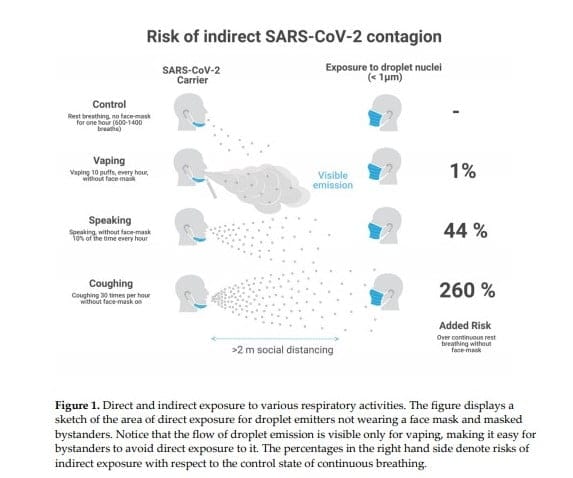Can smoking or vaping in outdoor spaces or close to other people increase the risk of transmission of Covid19? This is the question that has puzzled the scientific community in the past months. According to the latest study by COEHAR laboratories within the University of Catania, conducted by a group coordinated by Professor Riccardo Polosa, vaping increases the risk of transmitting the virus by only 1% compared to normal breathing.
For comparison, two minutes of coughing per hour increase the risk by over 260%, while talking for 6 minutes increase the risk by over 44%.
“Considering the length of vaping, the exposure time and the statistic data on the viral amount and the infection rates, the result confirm an additional risk of 1% compared to the normal breath rate in indoor spaces” stated Polosa.
World Health Organisation and the US Center for Disease Control and Prevention already acknowledged the role of the respiratory droplets in the direct aerial transmission of the SARS-CoV-2 virus.
CoEHAR researchers, Center of Excellence for the Acceleration of Harm Reduction, have gone further and, thanks to the collaboration with the Institute of Nuclear Sciences of Mexico City and the Myriad Pharmaceuticals of Auckland, evaluated the possibility that the droplets carried by the aerosol exhaled by an infected vaper would foster the transmission of COVID-19.
METHODOLOGY
With no previous research on respiratory droplets by Ecigs, the researchers used the exhalation data from cigarettes smoking as a representative model for the study. Available evidence indicates that smokers exhale a fluid mixture of smoke and air with a total volume of 30-40% greater than the normal resting breathing volume.
Considering the numbers of average puffs produced during the vaping activity, the size of the droplets, the SARS-CoV-2 viral load and other infection parameters, the study evaluates a random risk assessment for a home and restaurant scenarios with natural and mechanical ventilation.
CONCLUSION
The study assessed two different scenarios: private homes and public space, both outdoors and indoors. In the “home” scenario vaping does not increase significantly the risk compared to other behaviours, such as living together and talking.
In the second scenario in enclosed spaces with natural and mechanical ventilation, vaping adds 1% risk. Still, the opportunity of seeing the smoke released trough e-cigarette aerosol allows to visualize the puffs and avoid them, if needed.
“Studying and understanding the role of respiratory activities in the transmission of the virus is fundamental to improve the strategies to curb the infection and inform the population” stated Prof. Riccardo Polosa, author of the study.
“Nevertheless, although vaping represents a negligible risk of contagion, social distancing and wise behaviours are vital for the prevention” he added.




